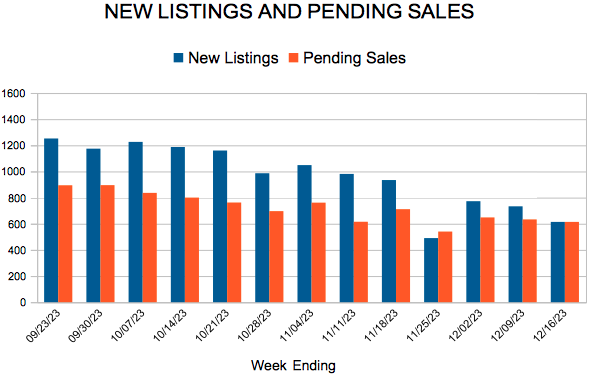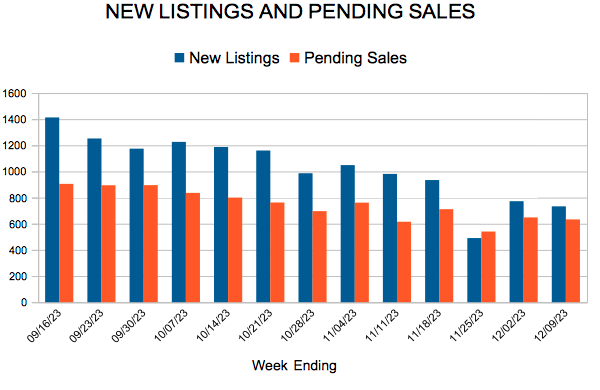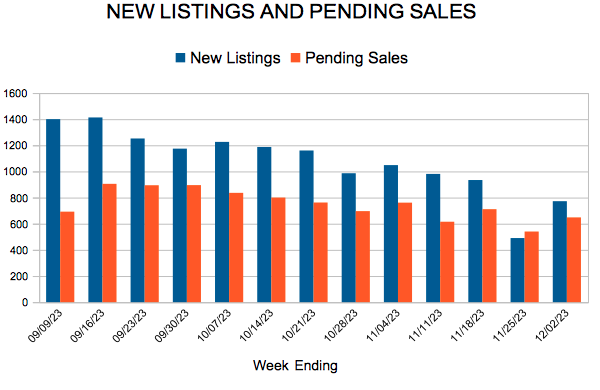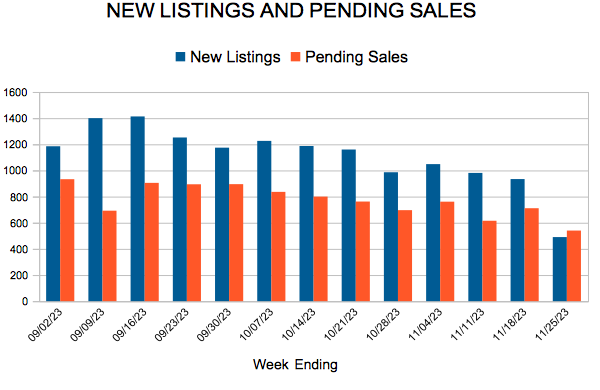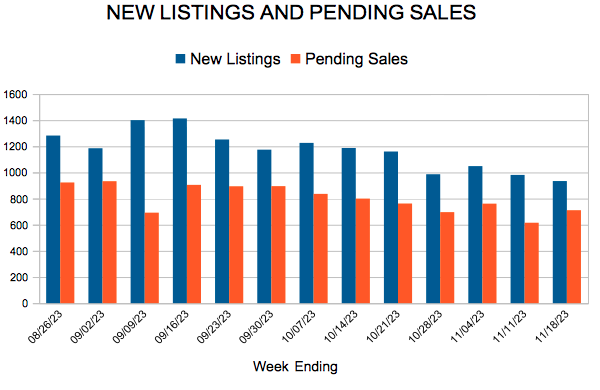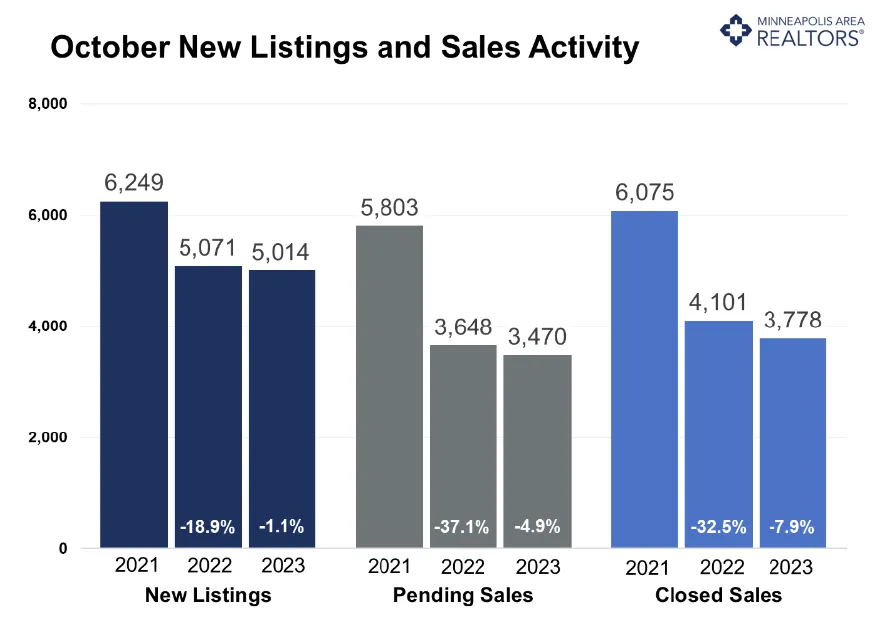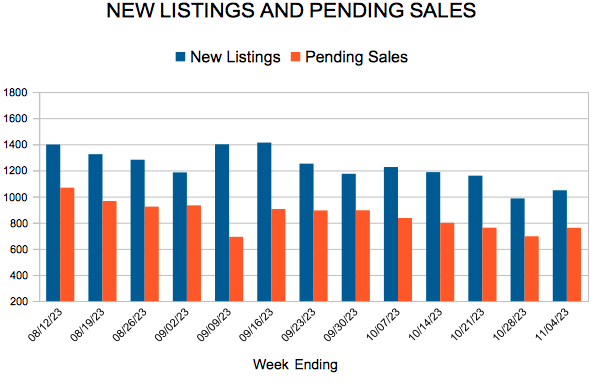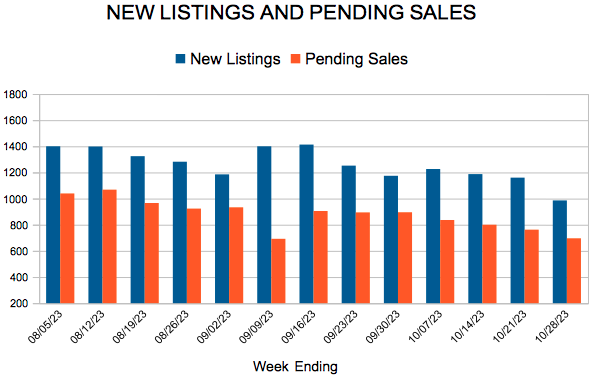New Listings and Pending Sales
Sales flatten and prices remain higher, meanwhile new listings rise and rates ease
- The median sales price increased 2.0% to $362,000
- Signed purchase agreements fell 1.5%; new listings up 5.3%
- Market times flat at 40 days; months’ supply up 10.5% to 2.1 months
(Dec. 15, 2023) – According to new data from Minneapolis Area REALTORS® and the Saint Paul Area Association of REALTORS®, metro-wide home prices rose slightly in November. Sales activity was flat as mortgage rates softened slightly and new listings were up 5.3%.
Sellers, Buyers and Housing Supply
Rates have eased from over 8.0% in mid-October to around 7.0% by the end of November. While still elevated relative to the last 20 years, that figure is below its 50-year average. In addition to a low baseline comparison, that decline has helped the number of signed purchase agreements stabilize in November. And because sellers weren’t feeling quite as stuck in their homes, the dip in rates helped boost seller activity as some felt more confident about listing their homes.
Slightly lower rates could mean more buyers will qualify and write offers, and that fewer sellers will feel “locked in” to their mortgage rates. While that could mean more listing activity, it’s likely to be met with demand that’s been pent up for a while in the current affordability environment. Come spring market of 2024, that balance between supply and demand may offer key insights into how the year could play out.
Buyers are still feeling the triple punch of low inventory, rising prices and still relatively high mortgage rates. Comparing pending sales to closed sales can offer unique insights into demand trends. Pending sales were down just 1.5% from last November and are a better leading indicator than closings. Closed sales—reflecting contracts mostly signed in September and October when rates were higher—were down 7.1%. On the supply side, inventory levels across the Twin Cities fell 5.1% compared to last November. While buyers are still finding limited options in their searches, deals are still occurring with some persistence and flexibility. In addition, the lack of existing inventory has benefited the new home market.
More buyers are choosing to deploy cash instead of paying today’s interest rates. Cash sales so far this year are at their highest level since 2014. Overall, since both supply and demand levels are lower, the relative balance hasn’t changed as much as expected. “The recent dip in rates has definitely spurred some buyer interest,” said Jerry Moscowitz, President of Minneapolis Area REALTORS®. “Buyers choosing to wait until spring should expect heightened competition.”
Prices, Market Times and Negotiations
Though seemingly counter-intuitive, home prices continued their ascent, up a modest 2.0% from last November. Prices are rising for several reasons.
- Supply is short as homeowners with favorable rates remain in their homes.
- Today’s buyers tend to be better off financially and often use cash for higher-priced homes as higher rates have hindered the mid-end buyer, meaning activity is skewing toward the higher end of the market.
- Luxury activity continues to outperform along with new construction activity that also skews toward the upper end.
Negotiations held firm but have balanced out recently. Sellers accepted 97.4% of their asking price, which was up from 2022 but down from 2021. Half the homes went under contract in under 23 days compared to 25 days last year. That figure was once again improved from 2022 but softer compared to 2021.
Those two indicators reflect the relatively strong position in which sellers still find themselves, assuming they’re willing to sell. For November, the median home price rose 2.0% to $362,000. The year as a whole will likely show 1.0 to 2.0% price growth. “Buyers seem more sensitive to changes in rates than to the rate itself,” said Brianne Lawrence, President of the Saint Paul Area Association of REALTORS®. “While even a full point decrease in the rate hasn’t magically solved our affordability issues, it does lower monthly payments slightly.”
Affordability, Rates and Payments
Even as the Federal Reserve paused their rate hikes, the impact of mortgage rates on monthly payments is significant. Mortgage rates hit a 23-year high in October but retreated nearly a full point since. The Housing Affordability Index reached its lowest level since at least 2004. Given rates, incomes and prices at the time, affordability was better in 2006 than it is today. Using some assumptions around taxes and insurance, the local monthly payment on the median priced home stands at $2,650 so far this year compared to $1,600 in 2020.
Location & Property Type
Market activity always varies by area, price point and property type. New home sales rose while existing home sales fell. Condo sales rose more than single family and townhome units. Purchase agreements were down 13.0% in St. Paul but up 14.5% in Minneapolis. Cities farther out such as Cologne, Princeton, New Prague and North Oaks saw among the largest sales gains while Monticello, Isanti and Shorewood all had weaker demand.
November 2023 Housing Takeaways (compared to a year ago)
- Sellers listed 3,657 properties on the market, a 5.3% increase from last November
- Buyers signed 2,807 purchase agreements, down 1.5% (3,261 closed sales, down 7.1%)
- Inventory levels shrank 5.1% to 7,819 units
- Month’s Supply of Inventory rose 10.5% to 2.1 months (4-6 months is balanced)
- The Median Sales Price was up 2.0 percent to $362,000
- Days on Market was flat at 40 days, on average (median of 23 days, down 8.0%)
- Changes in Pending Sales activity varied by market segment
- Single family sales decreased 1.8%; condo sales were up 12.7%; townhouse sales fell 4.9%
- Traditional sales declined 2.1%; foreclosure sales rose 71.4% to 36; short sales fell 25.0% to 6
- Previously owned sales were down 3.7%; new construction sales increased 22.3%
- Sales under $500,000 decreased 5.3%; sales over $500,000 were up 16.7%
New Listings and Pending Sales
New Listings and Pendings
New Listings and Pending Sales
New Listings and Pending Sales
Rates briefly break 8.0%, further burdening buyers and stifling sellers
- The median sales price increased 2.4% to $365,000
- Signed purchase agreements fell 4.9%; new listings down 1.1%
- Sellers still getting solid offers at 98.4% of list price in an average of 37 days
(Nov. 15, 2023) – According to new data from Minneapolis Area REALTORS® and the Saint Paul Area Association of REALTORS®, metro-wide home prices rose slightly in October. Sales activity slowed as mortgage rates weighed heavily on the marketplace even as listing activity could be flattening out.
Sellers, Buyers and Housing Supply
At around 8.0%, the fixed 30-year mortgage rate hit its highest level since 2000. Naturally, that weighed on home buyers who are already contending with tight inventory and rising prices. Pending sales were down 4.9% while closings were down 7.9%. It also weighed on would-be sellers and reinforces the “lock-in effect” where existing homeowners are unwilling to let go of their historically low mortgage rates. Sure enough, new listings declined 1.1%, which was the smallest decline since May of last year as the comparisons are more apples-to-apples. Townhomes and condos tend to be more affordable products. Townhome pending sales rose 6.5% while condo closed sales rose 8.4%. With existing homeowners clinging to their interest rate and low monthly payment, new home builders have captured a larger share of the market. New construction pending sales rose 31.6% in October compared to an 8.8% decline for existing homes. New home inventory rose 20.3% over the last 12 months compared to a 4.8% decline for previously owned properties.
Market-wide inventory levels fell 7.7% compared to last October. Millennials and Boomers alike are finding limited options and contending with affordability hurdles. More buyers are choosing to deploy cash instead of paying near 8.0% interest. Cash sales so far this year are at their highest level since 2014. To the surprise of many—and to varying degrees across the region, the market still feels “tight” with rising prices since both buyer and seller activity have declined. When housing supply levels rise but demand falls, that usually results in softening prices. Both supply and demand levels are lower, so the relative balance hasn’t changed as much as many expected. “Inventory is too low for prices to be falling much,” said Jerry Moscowitz, President of Minneapolis Area REALTORS®. “But rates are too high for prices to be rising much.”
Prices, Market Times and Negotiations
This combination of factors has also kept market times relatively brisk and negotiations still favoring sellers, but to a lesser degree than the last few years. Half the homes went under contract in under 20 days compared to 22 days last October, though the average market time rose slightly. Last month sellers accepted 98.4% of their original list price compared to 98.2% last year. Those two indicators reflect the surprisingly strong position in which many sellers still find themselves, assuming they’re willing to sell. This May was the only month of year-over-year price declines since February 2012. The year as a whole will likely show 1.0 to 2.0% price growth. For October, the median home price rose 2.4% to $365,000. “Buyers are feeling the triple punch of low inventory, rising prices and higher rates,” said Brianne Lawrence, President of the Saint Paul Area Association of REALTORS®. “That’s kept a good chunk of buyers sidelined and reflects a real shift from the last few years. That said, there has luckily been some easing in mortgage rates that may continue.”
Affordability, Rates and Payments
Even as the Federal Reserve paused their rate hikes, the impact of mortgage rates on monthly payments is significant. Mortgage rates hit a 23-year high recently. The Housing Affordability Index reached its lowest level since at least 2004. Given rates, incomes and prices at the time, affordability was better in 2006 than it is today. Using some assumptions around taxes and insurance, the monthly payment on the median priced home stands at $2,650 so far this year compared to $1,600 in 2020.
Location & Property Type
Market activity always varies by area, price point and property type. New home sales rose while existing home sales fell. Single family sales were down more than townhome and condo sales. Closings were down 13.9% in St. Paul but up 2.7% in Minneapolis. Cities such as St. Anthony, East Bethel, Somerset and Orono saw among the largest sales gains while New Hope, Robbinsdale and Mounds View all had notably lower demand than last year.
October 2023 Housing Takeaways (compared to a year ago)
- Sellers listed 5,014 properties on the market, a 1.1% decrease from last October
- Buyers signed 3,470 purchase agreements, down 4.9% (3,778 closed sales, down 7.9%)
- Inventory levels shrank 7.7% to 8,630 units
- Month’s Supply of Inventory rose 15.0% to 2.3 months (4-6 months is balanced)
- The Median Sales Price was up 2.4 percent to $365,000
- Days on Market rose 2.8% to 37 days, on average (median of 20 days, down 9.1%)
- Changes in Pending Sales activity varied by market segment
- Single family sales decreased 7.8%; condo sales were down 2.3%; townhouse sales rose 6.5%
- Traditional sales declined 5.1%; foreclosure sales rose 50.0% to 39; short sales fell 33.3% to 4
- Previously owned sales were down 8.8%; new construction sales increased 31.6%
- Sales under $500,000 decreased 6.4%; sales over $500,000 were up 2.7%
New Listings and Pending Sales
New Listings and Pending Sales
- « Previous Page
- 1
- …
- 10
- 11
- 12
- 13
- 14
- …
- 24
- Next Page »
